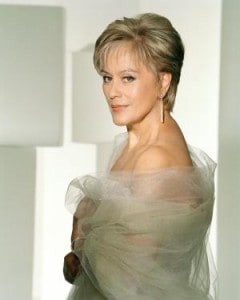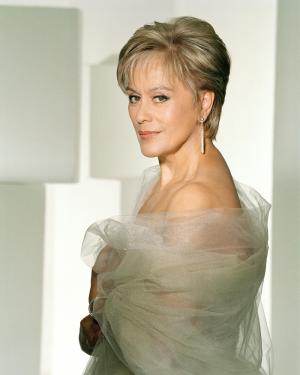
Like a fine mature wine, Te Kanawa’s voice took time to open up – but patience was worth it!
Have you ever opened that expensive bottle of wine you’d set aside to age – and found it tight and disappointing on first sip – only to realize that it needed to be decanted, allowed to breathe and open up – and then realize what a treat it is much later?
Last night I attended Dame Kiri Te Kanawa’s recital at the Marin Center in San Rafael with curiosity and admittedly skeptical anticipation. Te Kanawa recently turned 66 years old, and while I was eager to see this enormous star of the opera world live, I admit to assuming that her voice would be well past its prime.
My suspicions were validated – at first – and I almost elected to abandon the concert at the intermission, but I am truly glad to have stayed for the second half. By the end of the concert, and especially after her memorable encore, I felt honored to have been treated to the presence of greatness – yes, her voice is past its prime, but she – the singer, the performer, and the person – are certainly not.
Set I – works by Handel and Vivaldi
The opening set of 4 pieces from the classical period were disappointing to this reviewer. Te Kanawa’s voice appeared to have lost a great deal of its suppleness and agility – the fast runs in Vivaldi’s “Io son quel gelsomino” were uncontrolled in speed, precision, and intonation – and initially validated my prejudicial assumption that this once-great voice was essentially shot. Her vibrato sounded manufactured in her higher notes and towards the end of breaths and phrases, and her tonal color went through surprisingly sudden shifts on splayed “ee” vowels in her midrange in “Lascia ch’io pianga” – although the audience certainly enjoyed the piece, with several people audibly humming along to this well-known tune.
Set II – works by Franz Liszt
After a brief break, Te Kanawa returned to the stage and started talking to the audience about how difficult it is for her to handle the off-stage steps in the new gown she was wearing, since it was too tight and didn’t give her room to move. She was suddenly very engaging, personable, and open with the audience – and the audience responded warmly and enthusiastically. The concert hall and the performer suddenly took a turn for the better – and my note to myself was “did she just need time to warm up?” I enjoyed all 3 of her Liszt pieces – wondering not only if she was warmed up, but also if the more emotional and romantic music and lyrics were better-suited to this operatic singer’s voice, personality, and experience. This was most noticeable in the 3rd piece “Oh! Quand je dors” – her face, body, and voice were all much more involved, integrated, and expressive – and Te Kanawa the performer truly started to emerge. Her last high A was beautiful – a bit thin, but impressively controlled – and her face evoked pure feeling on the phrase “All at once my soul will awaken!”
Set III – works by Canteloube
Te Kanawa closed out the first half of her program with three delightful pieces from French composer Canteloube’s best-known collection “Chants d’Auvergne”, which are essentially orchestrated folksongs. His arrangements are full of tone-painting and passionate expression, and Te Kanawa performed these without disappointment. “The Cuckoo” was fun, lighthearted, and musically colorful; “La Delaissado” was sad and beautifully expressive, and the last piece, “Bailero”, was an impressionistic evocation of a shepherd by a stream. Pianist Brian Zeger delivered a brilliant accompaniment, beautifully painting a picture of a running stream. Te Kanawa’s facial expression, sensitivity to the lyrics, and performance were truly first rate and – yes – entertaining.
Second Half
After the intermission, Te Kanawa appeared in a different dress (which clearly provided her a greater range of motion) and looked as though she had been unshackled – she was more relaxed, moving more, and smiling more – as was the audience. The entire rest of the program was at a higher level than the first – especially compared with the disappointing first set – and she showed just why she holds such a vaunted place in the roster of opera greats.
Set IV – works by Hahn, Faure, and Debussy
Te Kanawa performed these 3 pieces from the French Impressionist period with appropriate color, light, and tone. Her pianissimo at the end of “Apres un Reve” was impressive, and her voice in Debussy’s “Romance” was beautifully opened up throughout her range – and she finished the song with a beautifully long legato line.
Set V – Traditional and folk songs
The snob in me was worried about this set – were we about to exit the “serous classical” world and enter the “crossover pop” phase that so many former opera singers succumb to?
My worries were immediately dispelled. Te Kanawa delivered Cullen’s beautiful arrangement of “Scarborough Fair” with drama and passion, and her control in the soft passages of “O Waly Waly” was matched by her unmelodramatic expressiveness.
But the highlight of this section, and perhaps of the entire concert, was her rendition of “Danny Boy”. This was no showpiece for an Irish tenor’s voice, as is usually commercially recorded – instead, this was a powerfully emotional and sensitive interpretation of the lyrics – which were in fact originally written to be sung by a woman to a man – or a mother to her son going off to war. Te Kanawa’s performance made this listener aware of the depth of meaning to these words heard so many times, and she truly moved me.
Set VI – works by Guastavino and Ginastera
Te Kanawa closed out her concert with three fun works which she performed with gusto, humor, personality, sparkle, and a hammy liveliness that put a smile on everyone’s face. Her high A at the end of “La Rosa y la sauce” prompted me to write “Where was that at the beginning of the recital??” In “Que Linda” she started to move even more, and her voice flowed even more as a result. Her final number, a tango-esque Ginastera, showed her letting her hair down and her hamminess out – and showed how much she truly loves to perform and entertain.
The audience was not going to let her go without an encore and she did not disappoint. As soon as the pianist started the introduction I could hear hundreds of breaths get sucked in – everyone recognizing the opening bars to one of Te Kanawa’s staple opera arias – Puccini’s “O mio babbino caro”. It was as if the entire auditorium were transported back 30 years, and the glory of Dame Kiri Te Kanawa emerged once again. As we headed for the exits I saw smiles on faces and Puccini’s melody being hummed by an audience that had been treated to a wonderful evening with one of opera’s greatest. This reviewer is glad to have stayed, let the bottle breathe, and enjoy the taste of greatness as well.
Reviewer’s note: to see Dame Kiri Te Kanawa perform “O mio babbino caro” in her prime, check out this YouTube video: https://www.youtube.com/watch?v=mDOCONwjbwg&feature=related


